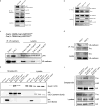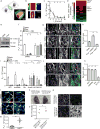A non-canonical Notch complex regulates adherens junctions and vascular barrier function
- PMID: 29160307
- PMCID: PMC5730479
- DOI: 10.1038/nature24998
A non-canonical Notch complex regulates adherens junctions and vascular barrier function
Abstract
The vascular barrier that separates blood from tissues is actively regulated by the endothelium and is essential for transport, inflammation, and haemostasis. Haemodynamic shear stress plays a critical role in maintaining endothelial barrier function, but how this occurs remains unknown. Here we use an engineered organotypic model of perfused microvessels to show that activation of the transmembrane receptor NOTCH1 directly regulates vascular barrier function through a non-canonical, transcription-independent signalling mechanism that drives assembly of adherens junctions, and confirm these findings in mouse models. Shear stress triggers DLL4-dependent proteolytic activation of NOTCH1 to expose the transmembrane domain of NOTCH1. This domain mediates establishment of the endothelial barrier; expression of the transmembrane domain of NOTCH1 is sufficient to rescue defects in barrier function induced by knockout of NOTCH1. The transmembrane domain restores barrier function by catalysing the formation of a receptor complex in the plasma membrane consisting of vascular endothelial cadherin, the transmembrane protein tyrosine phosphatase LAR, and the RAC1 guanidine-exchange factor TRIO. This complex activates RAC1 to drive assembly of adherens junctions and establish barrier function. Canonical transcriptional signalling via Notch is highly conserved in metazoans and is required for many processes in vascular development, including arterial-venous differentiation, angiogenesis and remodelling. We establish the existence of a non-canonical cortical NOTCH1 signalling pathway that regulates vascular barrier function, and thus provide a mechanism by which a single receptor might link transcriptional programs with adhesive and cytoskeletal remodelling.
Figures













Comment in
-
Notching a New Pathway in Vascular Flow Sensing.Trends Cell Biol. 2018 Mar;28(3):173-175. doi: 10.1016/j.tcb.2017.12.003. Epub 2018 Jan 2. Trends Cell Biol. 2018. PMID: 29305160
References
-
- Mehta D, Malik AB. Signaling mechanisms regulating endothelial permeability. Physiol. Rev. 2006;86:279–367. - PubMed
-
- Lawson ND, et al. Notch signaling is required for arterial-venous differentiation during embryonic vascular development. 2001;3683:3675–3683. - PubMed
-
- Hellström M, et al. Dll4 signalling through Notch1 regulates formation of tip cells during angiogenesis. Nature. 2007;445:776–780. - PubMed
Publication types
MeSH terms
Substances
Grants and funding
LinkOut - more resources
Full Text Sources
Other Literature Sources
Molecular Biology Databases
Research Materials
Miscellaneous

